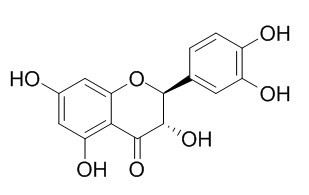(-)-Dihydroquercetin
Dihydroquercetin-rich extract (Lavitol) derived from the Dahurian larch tree, used as a food additive and as a dietary supplement ingredient.(+)-Dihydroquercetin has antioxidant activity, exhibits neuroprotective actions against the oxidative injuries induced in cortical cell cultures.
Inquire / Order:
manager@chemfaces.com
Technical Inquiries:
service@chemfaces.com
Tel:
+86-27-84237783
Fax:
+86-27-84254680
Address:
1 Building, No. 83, CheCheng Rd., Wuhan Economic and Technological Development Zone, Wuhan, Hubei 430056, PRC
Providing storage is as stated on the product vial and the vial is kept tightly sealed, the product can be stored for up to
24 months(2-8C).
Wherever possible, you should prepare and use solutions on the same day. However, if you need to make up stock solutions in advance, we recommend that you store the solution as aliquots in tightly sealed vials at -20C. Generally, these will be useable for up to two weeks. Before use, and prior to opening the vial we recommend that you allow your product to equilibrate to room temperature for at least 1 hour.
Need more advice on solubility, usage and handling? Please email to: service@chemfaces.com
The packaging of the product may have turned upside down during transportation, resulting in the natural compounds adhering to the neck or cap of the vial. take the vial out of its packaging and gently shake to let the compounds fall to the bottom of the vial. for liquid products, centrifuge at 200-500 RPM to gather the liquid at the bottom of the vial. try to avoid loss or contamination during handling.
Front Mol Neurosci.2023, 15:1083189.
Antioxidants (Basel).2021, 10(9):1435.
Chulalongkorn University2024, 4761190
Agriculture2022, 12(12), 2173.
J Nat Prod.2019, 82(4):1002-1008
Agriculture.2024, 69(3):140-148.
FEBS Lett.2015, 589(1):182-7
Pharmaceuticals (Basel).2024, 17(10):1368.
Int J Biol Macromol.2020, 161:1230-1239.
Biomed Chromatogr.2022, 36(11):e5462.
Related and Featured Products
Brain Res., 2003, 965(1-2):130-6.
Neuroprotective effects of antioxidative flavonoids, quercetin, (+)-dihydroquercetin and quercetin 3-methyl ether, isolated from Opuntia ficus-indica var. saboten.[Pubmed:
12591129]
The flavonoids quercetin, (+)-dihydroquercetin, and quercetin 3-methyl ether were isolated from the ethyl acetate fractions of the fruits and stems of Opuntia ficus-indica var. saboten.
METHODS AND RESULTS:
In the present study, we evaluated their protective effects against oxidative neuronal injuries induced in primary cultured rat cortical cells and their antioxidant activities by using three different cell-free bioassays. Quercetin was found to inhibit H(2)O(2)- or xanthine (X)/xanthine oxidase (XO)-induced oxidative neuronal cell injury, with an estimated IC(50) of 4-5 micro g/ml. However, it was no more protective at concentrations of 30 micro g/ml and above. (+)-Dihydroquercetin concentration-dependently inhibited oxidative neuronal injuries, but it was less potent than quercetin. On the other hand, quercetin 3-methyl ether potently and dramatically inhibited H(2)O(2)- and X/XO-induced neuronal injuries, with IC(50) values of 0.6 and 0.7 micro g/ml, respectively. All three principles markedly inhibited lipid peroxidation and scavenged 1,1-diphenyl-2-picrylhydrazyl free radicals. In addition, quercetin and quercetin 3-methyl ether were shown to inhibit XO activity in vitro, with respective IC(50) values of 10.67 and 42.01 micro g/ml.
CONCLUSIONS:
These results indicate that quercetin, (+)-dihydroquercetin, and quercetin 3-methyl ether are the active antioxidant principles in the fruits and stems of Opuntia ficus-indica var. saboten exhibiting neuroprotective actions against the oxidative injuries induced in cortical cell cultures. Furthermore, quercetin 3-methyl ether appears to be the most potent neuroprotectant of the three flavonoids isolated from this plant.
Int. J.Toxicol., 2015, 34(2): 243-310.
Toxicological and Genotoxicity Assessment of a Dihydroquercetin-Rich Dahurian Larch Tree (Larix gmelinii Rupr) Extract (Lavitol).[Pubmed:
25850419 ]
Safety assessment is reported of an orally ingested dihydroquercetin-rich extract (Lavitol) derived from the Dahurian larch tree, used as a food additive and as a dietary supplement ingredient.
METHODS AND RESULTS:
Dihydroquercetin, a potent antioxidant, is also known as taxifolin. The results of genotoxicity and toxicological tests (Comet assay, micronucleus test in human lymphocytes, chromosomal aberration test, subacute 7-day oral toxicity study, subchronic 90-day toxicology study with histopathologies, and, prenatal and postnatal developmental toxicity studies) on the extract provide further support for the safety of its consumption as a food supplement and food additive.



